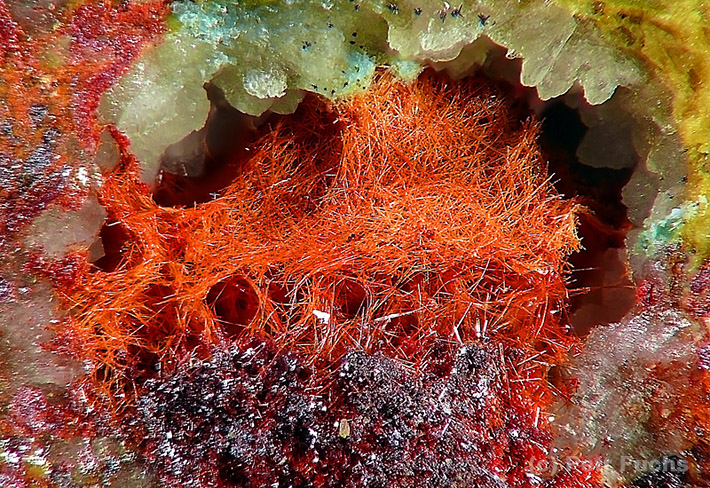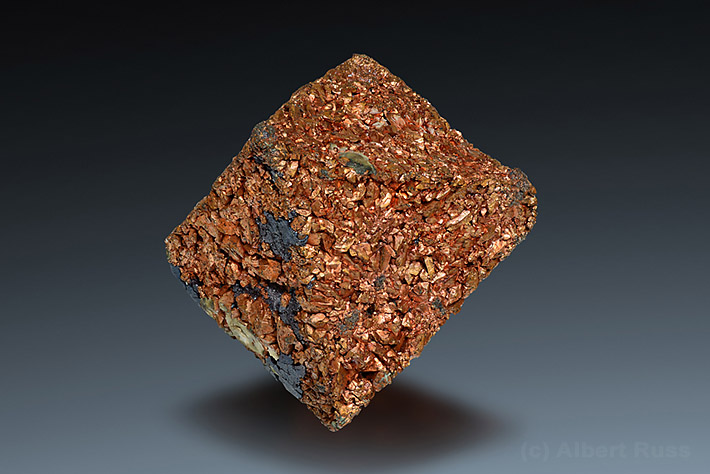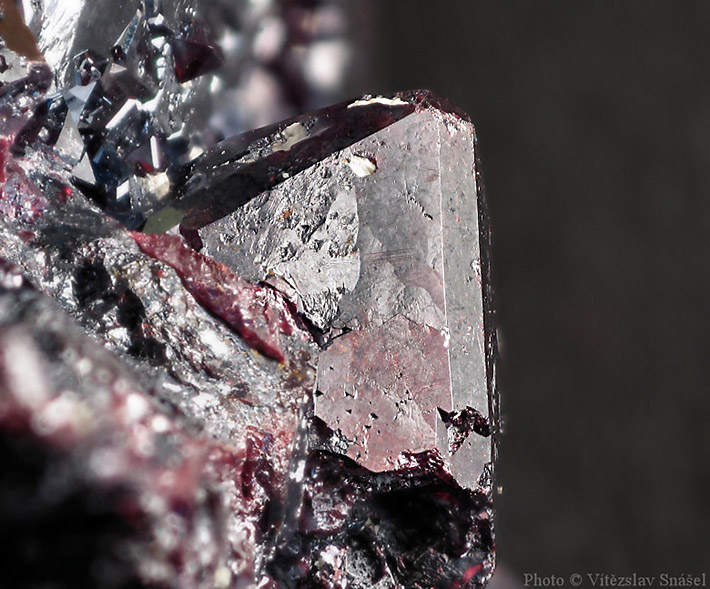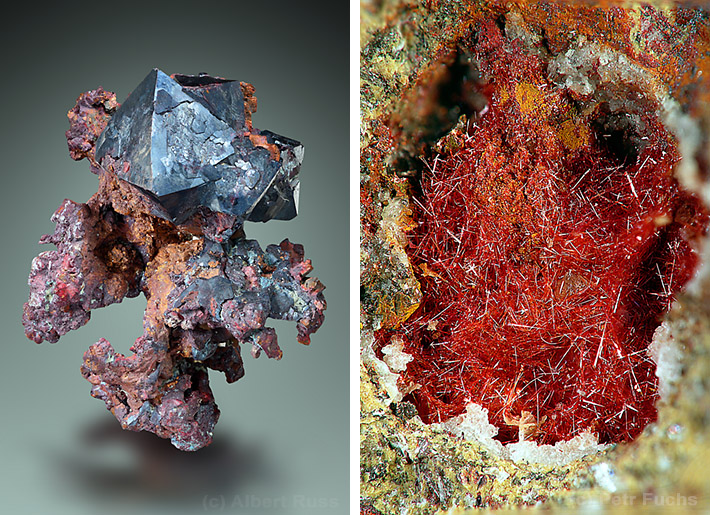Cuprite (copper I oxide) - Mineral Properties and Occurence
Cuprite is a minor ore of copper, usually appearing as secondary encrustations on primary copper ores. Nice and rare cuprite crystals are a popular among collectors. It is prized as a gemstone because of its vivid red internal reflection, but its softness precludes wide use in jewelry.
Crystal Structure of Cuprite
Cuprite is a simple copper I oxide mineral (Cu2O) which crystallizes in the isometric (cubic) system. Cuprite appears as groups of octahedral crystals or combinations of cubic, octahedral or dodecahedral forms. Penetration twins are common, and crystals may show striations or growth patterns. Cuprite also occurs in an unusual hopper form (a

Great cluster of perfect cuprite octahedrons and native copper from Rubtsovsk, Russia. Size: 6 x 6 cm. Collection: Petr Berg, photo: Albert Russ
Cuprite also crystallizes as masses of fibrous, elongated capillary and radiating needles. Bright red crystals which are greatly elongated parallel to {001} are referred to as chalcotrichite.
Cuprite quite often coats native copper or other copper minerals. It is also sometimes coated or completely pseudomorphed by green malachite.
Physical Properties of Cuprite
Cuprite occurs in innumerable shades of red: bright, cherry, ruby, brownish, dark and purplish, as well as reddish-black and dark gray. Opaque crystals will display distinct red edges when backlit. Thin specimens are both translucent and transparent.

Tiny bright red needles of red chalcotrichite crystals from Studenec, Czech Republic. Size: 5 x 4 mm. Photo: Petr Fuchs
Cuprite is mildly pleochroic, with fair cleavage in 4 directions. Its luster is earthy, or submetallic to adamantine. Its fracture is conchoidal to uneven. Cuprite streak is a shining metallic brownish-red, its hardness is 3.5-4.0, and its density is 6.14.
Associated Minerals
Cuprite is generally found in association with most of the copper minerals: native copper, sulfides (bornite, tetrahedrite and chalcopyrite), carbonates (blue azurite, green malachite), silicates (chrysocolla) and oxides (tenorite), along with native silver and a variety of iron oxides.
Naming and Discovery
According to one web source, cuprite may have been observed as early as 1546, but Wilhelm Karl von Haidinger (1795-1871), a polymath Austrian mineralogist, is credited with naming and describing it definitively in 1845, deriving the name from the Latin cuprum for its copper content. Von Haidinger was a close associate of Friedrich Mohs (of Mohs' hardness fame), and a truly prolific scientist in his own right. He published over 350 scientific articles on mineralogy, an atlas of a famed text on mineralogy and a comprehensive geologic map of Austria-Hungary. In his lifetime he also found time to render an English translation of Mohs' Treatise on Mineralogy; specialized in the study of pseudomorphism (the ability of one mineral to assume the physical attributes of a precursor); discovered pleochroism (the property that enables specimen color to change based on observed crystallographic orientation); and supported the research that led to a fuller understanding of the varied conditions that permitted dolomite formation.

Partial pseudomorph of native copper after cuprite from Rubtsovsk, Russia. Size: 2 x 2 cm. Collection: Peter Berg, photo: Albert Russ
Origin
Cuprite is a common product of oxidation (weathering) of primary copper minerals. It can create coatings on the sulfidic copper minerals like chalcopyrite or bornite but it can also occur as a tiny film on native copper. Native copper in magmatic deposits is often primary but it is a secondary mineral on most sulfidic copper deposits. Cuprite is not very stable in a wet environment and can be replaced by a younger hydrated copper carbonate - malachite.
Applications
Faceted cuprite specimens of any size are considered to be one of the most collectible and spectacular gemstones in existence. Typically, such stones are deeply garnet-colored and display a higher brilliance than diamond. Unfortunately, most cuprite crystals are too small to be faceted, and the Mohs softness of larger valuable stones precludes their use in jewelry.

Combination of two octahedron shapes on a single cuprite crystal from Rubstovsk, Russia. Size: 10 x 12 mm. Photo: Vitezslav Snasel
Occurrence of Cuprite
One unique deposit in Africa (Onganja, at Seeis in Namibia), discovered in the 1970s, is the sole source of nearly all gem-quality faceted stones over 1 carat (0.2 grams), and it was exhausted years ago. Great specimens came also from Tsumeb in Namibia and Katanga in Congo.
In Russia, the Altai Mountains have recently yielded lustrous octahedral crystal masses from the Rubtsovoskoe Mine, where it creates awesome combinations with native copper and silver. Similar occurrences are reported from the Ural Mountains at Dzezkazgan, Kazakhstan.
In England, the Cornwall area is a classic producer, with well-known localities at the Camborne/Redruth/St Day District and Wheal Phoenix and Caradon and Linkinhorne in the Liskeard District. In France, two remarkable occurrences are found at Le Moulinal Mine, Paulinet and Chessy, Rhône (the latter especially noted for pseudomorphs of malachite).

Left: Cuprite octahedrons connected by the native copper from Rubtsovsk, Russia. Size: 5 x 3 cm. Collection: Petr Berg, photo: Albert Russ Right: Bright red chalcotrichite from Studenec, Czech Republic. Size: 10 x 8 mm. Photo: Petr Fuchs
In China, both well-formed cubic crystals and chalcotrichite have come from the Fengjiashan Mine, Daye, Hubei Province and the Chengmenshan Mine, Jiurui, Jiangxi Province.
In Australia, bright cherry-red crystals occur in the Red Dome Mine, Chillagoe, Queensland.
The U.S. State of Arizona is predictably known for numerous cuprite occurrences, owing to the abundance of large, well-developed porphyry copper deposits. The most prolific mines have been at the Bisbee Mine in Cochise County, the Ray Mine in Pinal County, and the New Cornelia Mine at Ajo in Pima County.





Comments